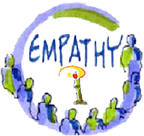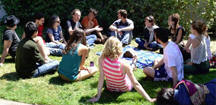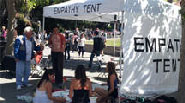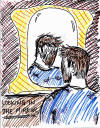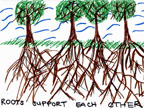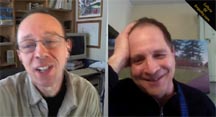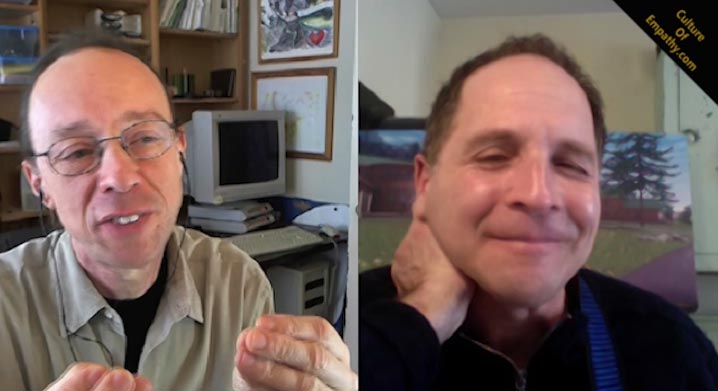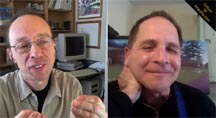|
|
|
Culture of Empathy
Builder:
David A. Levine
David A
Levine & Edwin Rutsch: Dialogs on How to Build a Culture of Empathy in
Education
Free-form rambling may be the
best way to discuss empathy, because empathy is not a set of
prescriptions. It is a culture, a consciousness. Empathy is an
intention. Schools tend to look for something so the kids will be nicer,
but the adults are informing the culture as well. There is the inner
nature of understanding our own emotions, and the outer nature of
understanding how our environment begets responses from us.
2:30-4:30
Teaching Empathy was written in 2005, published by Solution Tree. Even
as early as then, the book was a second attempt at such a project. Back
in the late 80’s, I [Levine] had been working with music as a way to
explore emotional material, and publishers all told me it was a great
idea, but that they would not publish it. So I published it myself, and
Solution Tree found it and asked me to work on it further for them.
4:30-7:45
I fell into empathy education via my interest in music. I grew up with
two musicians, often falling asleep to their playing, and joining my
parents and their friends in communal instrumentation (I played the
fiddle). We crossed cultures and generations, and I realized music's
power as a catalyst for community building. And my focus turned toward
children, so I entered the school system. At one point I was working for
the Department of Education's drug prevention program, touring
classrooms with my guitar. And one girl, seeing my guitar, asked me,
“Are you going to sing some self-esteem feel good songs?” And we
laughed, “Because we are in eighth grade, and if you tell us what to do,
we will not listen.” So I asked her, “What would you like me to do?” And
she told me not to talk down to them, to make it real. And I never
forgot her words. And that was 1989.
7:45-8:30
Since then, I have looked for the most effective and efficient ways to
create an emotionally safe learning environment, one in which we can
face our challenges together. Because we are often enduring similar
circumstances though we may not know it. It If we can learn the skills
of listening and non-judgment, we can create empathy, and from that,
understanding.
8:30-9:30
I [Rutsch] have advocated creating a culture of empathy, and it sounds
like you have come to that through the use of music and the arts, in the
way that communities used the bonfire to play music and tell stories and
bond.
9:30-12:05
I [Levine] seen schools attempt programs, but as long as they are not
integrated into the culture of the school, they will be only programs.
Culture is the way we do things; climate is how we feel about it. And we
build those with ritual and connection. One way to connect is through
common language, and as a musician there is nothing better than playing
music with someone else, and being in flow with that person. It is not
just empathy education, or empathy community, but a multifaceted
empathic approach that gives rise to connection, belonging, and
community.
12:05-12:55
One of the ways I [Rutsch] have come to understand connection is through
dance. And it seems that dance and the arts our first to be downsized in
the education system.
12:55-19:50
Yes, and empathetic conversation that is itself an art form. Peter Senge
said that dialogue is collectively exploring an issue, in which each of
us comes to an understanding of where we are in this issue. Schools are
cutting the arts and social and emotional learning. What gets measured
gets done. And they are not measuring prosocial skills, unless there is
an antisocial issue, like bullying. Soon after Obama was elected
president, I [Levine] was driving into the Bronx, listening to him
giving a speech on the radio. And he was discussing empathy, at the
International Prayer Breakfast, and how religions all come back to the
Golden Rule. And I felt his belief in it, I believe he cares about this.
And working in the Bronx, I know his election symbolizes opportunity for
many minorities in the United States. So I said, “Today we are going to
do a class on the Golden Rule.” And we went through the class, and I
mentioned the speech from Obama, and all their smiles broke out. And at
the end of the class, little boy said to me, “Mister Levine, I wish this
was a subject in schools.” And this is why we need to make empathy and
education a movement.
19:50-20:30
You [Levine] seem to really care about this connection part of empathy.
When we are alone, and feel loneliness, there is a kind of pain. And we
seem to need to have this connection to be well formed individuals.
20:30-24:20
I [Levine] think that comes back to this covering our soul’s purpose.
Nothing is more powerful than being in touch with that. And that is
diversity education at its best, because we are all different. And
sometimes we sacrifice that in order to be part of a group. I saw David
Brooks give a TED.com lecture, in which he mentions seeing political
figures from both sides of the aisle very close to one another in
private and become separate in the spotlight, and that this has to
influence policy. And I think the same is true in education. I involved
with something called the Ashokan Foundation, and we are hosting an
event on May 11, in which we discuss empathy in education. And any time
we do this, all the educators who come are very excited and passionate
about this, but when they get back to school, and have to outline their
budgets, they have to ask, “What will be Department of Education pay
for?” And they do not pay for the empathy components. We have to
remember that we are here in schools for the future of our children,
which is essentially the future of the world.
24:20-26:05
It is interesting how empathy and education helps promote empathy in the
world and in the world's future, and meanwhile, we need more empathy in
the world to help promote empathy in education, to recognize it as
important. All these different disciplines seem to be very
interconnected. You [Levine] are involved with the Ashokan Foundation,
which seems to handle empathy and education.
26:05-29:05
There is something called Ashoka, which promotes social
entrepreneurship, particularly with children and schools. I [Levine]
work with something called Ashokan, and I am trying to get Ashoka at
Ashokan. We are not the same, but we want the same things. I love the
idea of global empathy, and I think for me it really comes down to human
relationships, the relationships we intentionally cultivate. With
empathy, we can disagree but we can still honor and respect each other.
I think the greatest empathy skill is empathetic listening,
non-judgment, and feed back to them what we think they think and feel
and need. When we can put aside content and agenda, that is what brings
people together, and that is how we can resolve conflict.
29:05-32:20
In Stephen Covey's book, The Eighth Habit, he talks about
stimulus-response, and that there is a moment we can put in between the
two: reflection. And that is the place that magically shows up, I think
more often when we feel a tenderness for the other person. I [Levine]
remember after 9/11, there was a great tenderness for each other in the
country. Of course, over time, that fades away. If we are successful in
this global empathy movement, we will create that tenderness, what I
call an emotionally safe learning environment.
32:20-33:30
I [Rutsch] remember feeling that as well after 9/11. One of the
questions I ask is, “What would a culture of empathy look like?” I
wonder about that tenderness, and when I become aware that, my eyes tear
up, and they get a sense that this is too much.
33:30-42:45
You [Rutsch] mentioned before about feeling loneliness. If I am
connected with who I am, I will not feel that even if I am by myself. I
once asked my friend, “Why am I crying?” And she said, “When the soul is
touched, we cry.” I think we are all waiting for that. There is a
constriction, like a massage, and then it releases. And that is
enlivening. And you cannot create this culture of empathy with binder, a
program. But you can create the conditions for group resonance. A lot of
my work is inspired by Doctor William Glasser, who came up with
something kind of like Maslow's Hierarchy of Needs. And just as there
are physical needs, there are emotional needs. Doctor Glasser posits for
emotional needs: belonging (community), power (not over others, but empowered),
freedom (voice – public praise, private correction), and fun (feeling
engaged and having healthy relationships). People involved in social
emotional learning are often critical of teachers, which is neither
helpful nor true. The point of the list of needs, is to create a
blueprint for a emotional safety, as well as a way to assess the
motivations of behavior. We need to see our behaviors as codes of
communication. By decoding behavior, we are practicing empathy, and
meeting our needs.
42:45-44:35
‘Needs’ reminds me [Rutsch] of nonviolent communication, sometimes
called compassionate communication. They discuss needs, and offer many
needs rather than for. Sometimes I think of empathy itself is a need.
With research showing influences of oxytocin and cortisol, there seems
to be a physical use for empathy.
44:35-46:15
I [Levine] first heard of nonviolent communication from someone who had
discovered my book and asked me if I was familiar with it. My book is
geared more toward educators, and she thought that it would be a good
entrée for her work with nonviolent communication. My understanding is
that it provides a framework for being present to the other persons’
multi-dimensions, and to help them see what is going on with them,
because often we have blind spots.
46:15-47:45
I [Rutsch] think of it as one of many methods, the arts being one of
them, to connect and to fulfill these needs. NVC comes out of the work
of Carl Rogers and Marshall Rosenberg, and they discuss the idea of
these needs as well.
47:45-53:55
My [Levine] mentor, Doctor Gerald Edwards was Rogerian. We had meetings
in which the autofocus was to remain present. Emotion is kind of like
the energetics between people. Like you, I am a synthesizer, and I try
to pull from different fields, such as the arts, in my teachings. I
maybe repeating myself, but if we are going to work with kids, then we
have to work with each other and with ourselves. That is the inner
nature coming through to the outer nature. We have chickens here, which
you may be hearing during this interview, and sometimes I hold the baby
chicks, and I think anyone holding a baby chick or a puppy or a baby
(like with Mary Gordon's work in Roots of Empathy) feels an empathic
response. A friend of mine once suggested a tape for me, and when
listening to it I felt what Daniel Goleman calls an emotional memory,
and I had to pull over and let myself cry. So I learned the song, and
when I first played it for a class in 1986, they could not stop talking
about it. It is about a kid who likes someone named Howard Gray, but is
afraid to be his friend. After I sing the song, we discuss bullying and
why we do it and how it feels. And one day, in 1989, I just wrote
empathy on the board, and I said, “Empathy is looking into someone
else's picture of the world.” And that was when I knew in my heart that
this is what I was supposed to do.
53:55-55:30
[While Levine get his guitar, Rutsch browses Levine’s website]
55:30-1:00:15
Howard Gray by Lee Domann
Most everyone I knew put
the whole Gray family down
1:00:15-1:00:50
That reminded me [Rutsch] of when I was growing up, we would tease
another kid. He was a little overweight, and we were a little
relentless, until he broke down and started crying. That reminded me of
that, and I think we all have those kinds of memories.
1:00:50-1:05:35
Adults will often have memories about this, and they look back on those
choices that they made. Children want to talk about this. They all felt
that, and sometimes it is easier to talk about difficult emotions and
issues when it is someone else's story. On Lee Domann's website, he
details the writing of the song. One daily did find Howard Gray, and I
[Levine] made a video of their discussion. It is very illuminating to
see the consequences of the experience. Children are very savvy about
contrived lessons of how they should act. It is an art form to be able
to facilitate conversations that are real. Sometimes I think the best
learning is after-the-fact, like two weeks after you see a movie. A
principle once said to me, “We stick it in their faces all the time,”
and I thought, “So you are going to bully kids not to bully?” That is
not what it is about; it is about coming together in accepting that we
all have challenges about how we feel. And if we can do that, the
challenges will still be there, but they will be softer around the
edges. Peter Senge talked about creating a container, and emotionally
safe learning environment, and I think of our four emotional needs as
the four walls of the container.
1:05:35-1:07:00
There is so much more I [Rutsch] would love to explore with you, about
your book, and perhaps with some of the other people with whom you are
working.
1:07:00-1:10:50
Some time ago, I [Levine] read an article that claimed that Ann Arbor,
Michigan was a dying city. And in response, the city made a music video
of the population lip-synching to the song American Pie. And it woke up
the city, and celebrated and renewed the life and the culture it had. I
think that is what we need to do around an empathic culture, is wake up
and group lip-synch. And we are doing this event at the
AshokanCenter.org - and this symposium is really the beginning. I get
contacted from all over the world about my book, one guy in India even
built a school around it, and I would love a way for us to all connect.
1:10:50-1:12:05
Johan Galtung says, “Peace is resolving conflict with empathy,
nonviolence, and creativity, and it is a never-ending process,” and for
me [Rutsch] empathy inherently has the nonviolence in it. It sounds to
me like you are looking for some kind of event to get us going.
1:12:05-1:14:35
Drove my Chevy to the levee, but the levee was dry. And we got to fill
that levee up. We have something at the Ashokan Center, that practices
community building through dance. I think we can use that to help create
this event, maybe a day of empathy.
1:14:35-1:15:50
Right now, I [Rutsch] networking and connecting people who value
empathy, and then I would like to do something with the arts.
1:15:50-1:17:40
Sometimes problem-solving is strengthened through metaphorical thinking.
My [Levine] metaphor for empathy is a warm embrace, this feeling of
home.
I [Rutsch] have heard of empathy as Gabriel’s embrace when traveling
Dante’s inferno.
1:17:40-1:20:45
I think the two main camps of empathy are the cognitive and the
neuroscience side, and the hard side, where I am. The word ‘to heal’
means to come back together, to become whole. And we can become whole,
and then, connect with another. It is the greatest gift. We can
experience it at any time, and to learn it through that experience.
1:20:45-1:23:25
We were discussing the definitions of empathy. I see four components:
self-empathy, mirror empathy (what we talk most about), imaginative
empathy (as with actors), and empathic action (mediation). I have heard
that empathy is when the blocks to action are removed.
1:23:25-
I call it EEA:
Event (something happens),
Empathy (imagine what the people involved feel and need),
Action (what do we do about it).
Empathy and imagination are the middle place in the stimulus-response.
We need to see empathy as action.
Teaching Empathy
w/ David Levine "David A. Levine is a teacher, author, empathy educator, musician and recording artist. He is currently the Director of the School of Belonging Training Institute. After teaching elementary and middle school, David became the chief trainer for the U.S. Department of Education's Northeast Regional Center for Safe and Drug-Free Schools. It was during that time that he created a framework for social culture building he calls The School of Belonging."
Empathy 101: Practice before you teach. "Forget formulas and textbook responses: empathy is about listening, says Teaching Empathy author David Levine. And that begins with teachers' relationships to their students."
"Educator and author David A. Levine is interviewed by Michel Martin on
her show Tell Me More on National Public Radio. The topic it teaching
empathy in school."
==================================================================
Book Notes:
Teaching Empathy: A Blueprint for Caring, Compassion, and Community
Teaching Empathy w/ David Levine
"David A. Levine is a teacher, author, empathy educator, musician and recording artist. He is currently the Director of the School of Belonging Training Institute. After teaching elementary and middle school, David became the chief trainer for the U.S. Department of Education's Northeast Regional Center for Safe and Drug-Free Schools. It was during that time that he created a framework for social culture building he calls The School of Belonging. The School of Belonging is a social consciousness process that emphasizes relationship building, compassion in practice, social skills development and reflective practice as the primary components of a healthy and effective school. This change process is highlighted in his books Teaching Empathy, Building Classroom communities, and The School of Belonging Plan Book. ""
| |||||||||||||||
